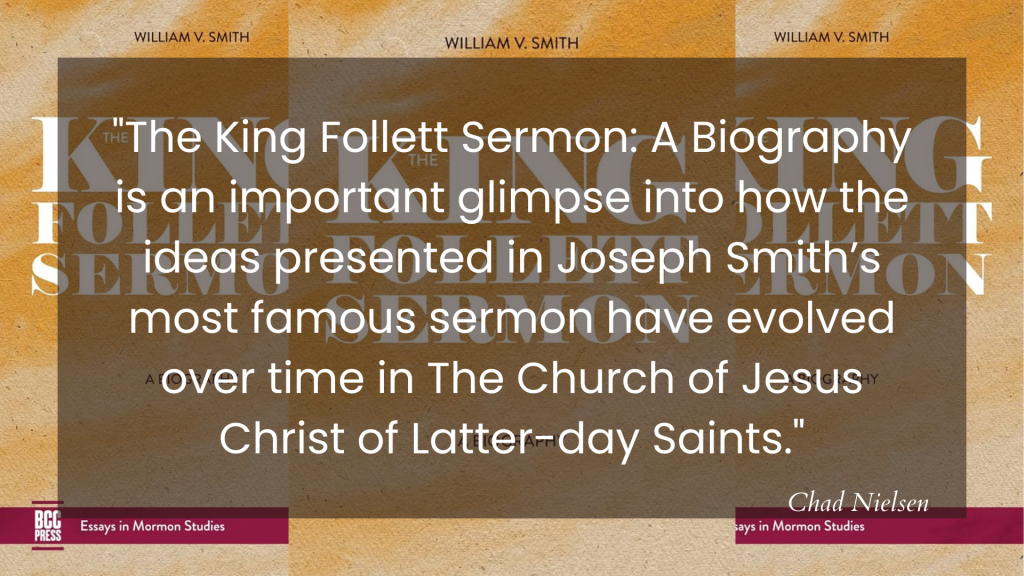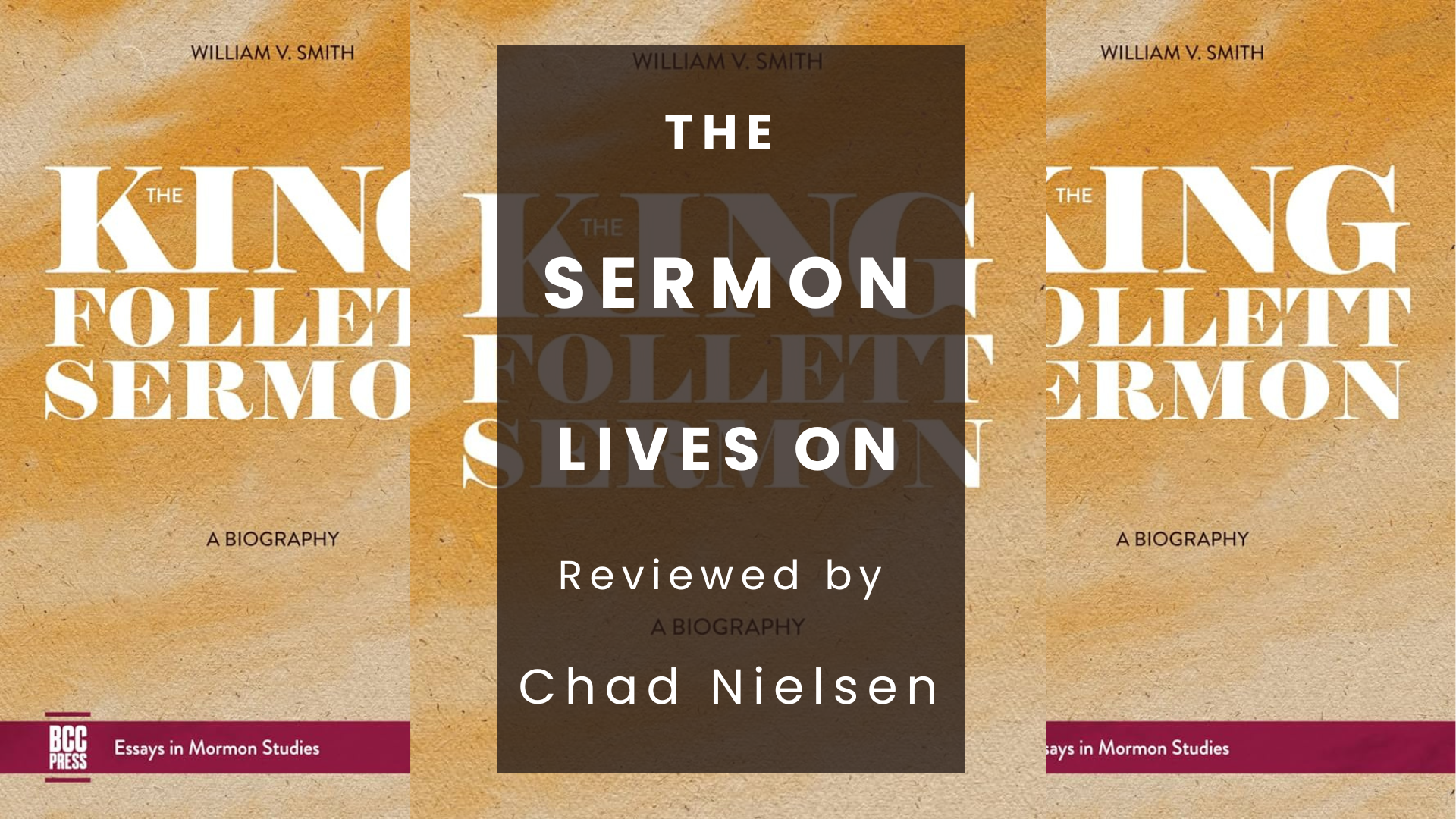Articles/Essays – Volume 57, No. 3
The Sermon Lives On | William V. Smith, The King Follett Sermon: A Biography
When I picked up William V. Smith’s The King Follett Sermon: A Biography, I was expecting to find a history of the text of the famous sermon from April 1844. I found that it was indeed that but also more—a work of historical Latter-day Saint theology on the nature of God and humans, the resurrection of children, the meaning of afterlife, and the history of polygamy. In particular, it focuses on a golden age of Latter-day Saint theology, when B. H. Roberts, James E. Talmage, Joseph F. Smith, and Charles Penrose were working on systematic theologies and the role that the King Follett Sermon played in their efforts and interactions.
By virtue of its area of focus, the book shares a lot with Eric A. Eliason and Terryl L. Givens’s special issue of BYU Studies Quarterly published in 2021 and titled Yet to Be Revealed: Open Questions in Latter-day Saint Theology, though it does have a different approach. Rather than essays focusing on individual topics, Smith’s volume focuses on the development of the doctrine of specific leaders and thinkers working in dialogue with each other and with the text of the King Follett Sermon. Despite sharing a lot of the same discussion points—particularly with James E. Faulconer and Susannah Morrison’s chapter on the King Follett Sermon in Yet to Be Revealed—Smith’s King Follet Sermon differs. For example, Faulconer and Morrison write that it “may be neither the pinnacle of Joseph Smith’s teachings nor peripheral to it” but instead “the most important mirror of a Latter-day Saint’s theological self-understanding” (102–04). William V. Smith agrees that the sermon does not succeed as “a statement of belief for all time,” but he adds an incredible amount of context to the statement. For example, he draws upon his previous work in Textual Studies of the Doctrine and Covenants: The Plural Marriage Revelation as he highlights the role of polygamy in shaping an understanding of spirit birth that differed from the ideas presented in the King Follett Sermon. In time, Smith observes, different camps evolved in the Church relative to the King Follett Sermon, with more liberal thinkers (often career university professors) embracing the reconciling framework proposed by B. H. Roberts, while a group ensconced more in fundamentalist Protestant paradigms embraced a framework that reacts against the King Follett Sermon. Hence, “Follett in many ways is an important—if rather invisible—anchor of belief in the Church of Jesus Christ of Latter-day Saints” (263). Thus, Smith concludes, it is “a fractured hidden Standard Work of Latter-day Saints” (267).

Given the early twentieth century era that serves as the focal point in William V. Smith’s book, it also works in dialogue with biographies of B. H. Roberts. John Sillito’s B. H. Roberts: A Life in the Public Arena (Salt Lake City: Signature Books, 2021) intentionally avoids delving into Roberts’s doctrinal thoughts but does highlight some of the same doctrinal clashes with Joseph F. Smith, such as a 1909 general conference address where Roberts openly described past prophets as fallible men, as well as Joseph F.’s frustration with Roberts’s political involvement.[1] Truman G. Madsen’s Defender of the Faith: The B. H. Roberts Story (Salt Lake City: Bookcraft, 1980) is more applicable, since it does discuss the history of B. H. Roberts’s doctrinal thought, though Madsen does tend to shy away from conflict with Joseph F. Smith. Regardless, Madsen does discuss how “little that Roberts wrote ever escaped controversy,” including his work on the Documentary History of the Church. He also discusses Roberts’s “The Immortality of Man” article, which provided a framework for reconciling spirit birth with the idea of spirit adoption in the King Follet Sermon.[2] Both of these biographies of Roberts fail, however, to discuss the role of his efforts to publish and discuss the King Follett Sermon during the 1907–1912 era when he was being marginalized by other Church leaders, something for which William V. Smith makes a strong case.
Smith’s book provides a fairly comprehensive overview of both the history of the published versions of the sermon and discussions about the text within the Church. It felt, however, that he got a bit distracted from time to time while diving into tangents. Even those tangents proved interesting, however, including a brief overview of Jonathan Grimshaw’s life beyond the compilation of the standard King Follett Sermon text.
The King Follett Sermon: A Biography is an important glimpse into how the ideas presented in Joseph Smith’s most famous sermon have evolved over time in the Church of Jesus Christ of Latter-day Saints. In providing this glimpse, it poses important questions about what it means to be a living organization that embraces ongoing revelation. In particular, it asks: to what extent are members of the Church beholden to Joseph Smith Jr. as the founding prophet for all of their beliefs and to what extent are later leaders allowed to modify or directly contradict Joseph Smith’s teachings? William V. Smith’s work doesn’t answer these questions directly, but it does provide examples of key moments of doctrinal shifts and debates since Joseph Smith’s death in 1844.
William V. Smith. The King Follett Sermon: A Biography. By Common Consent Press, 2023. 380 pp. Paper: $12.95. ISBN: 978-1948218856.
[1] John Sillito, B. H. Roberts: A Life in the Public Arena (Salt Lake City: Signature Books, 2021), 406–16.
[2] Truman G. Madsen, Defender of the Faith: The B. H. Roberts Story (Salt Lake City: Bookcraft, 1980), 291, 297–98.


 Back to full Issue
Back to full Issue

